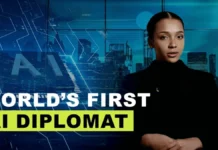Despite the emergence of new technologies the task of evaluating public diplomacy activities remains a daunting one. While scholars and practitioners have offered numerous definitions for the term public diplomacy, they have yet to agree upon a method for measuring the impact of public diplomacy activities.
Some have suggested that public diplomacy is a means towards creating a receptive environment for one’s foreign policy. This definition suggests that one has to gauge the environment in which public diplomacy is practiced and track changes within this environment. But what is this “environment”? Are there several actors comprising this environment? If so, which actors should be monitored? And how can this monitoring take place?
Other definitions state that public diplomacy is a tool for winning over the “hearts and minds” of foreign populations and swaying foreign public opinion in one’s favor. Yet how can one assess his ability to win over hearts and minds? Should he preform a longitudinal study charting public opinion over time? Or should he create a sample that is monitored throughout a public diplomacy campaign? Or perhaps he should measure public opinion before and after a campaign? But even if one did all these things, could he demonstrate causality and prove that his campaign brought about the changes in public opinion?
And, as always, the question that follows is: who is the “foreign public” that is being analyzed? Is this public comprised of regular citizens? Opinion makers? Policy makers? The media?
The digitalization of public diplomacy promised to enhance one’s ability to assess public diplomacy activities. By using websites and social media profiles, diplomats could analyze their audience base, assess audience engagement with content and measure the content’ reach. Parameters such as reach, Like and Shares were all seen as positive indicators of public diplomacy success. Yet diplomats and MFAs soon learned that reach and Likes were hollow markers that did not accurately evaluate public attitude and public opinion.
The next wave of digitalization again promised to enhance public diplomacy evaluation. Using network analysis MFAs could analyze how far their content travels online and the diversity of audiences it reaches. Similarly, diplomats could use network analysis to identify online influencers who could endorse diplomats’ messages and increase their reach. Big data analysis could be used to evaluate online rhetoric before and after a public diplomacy campaign so as to track changes in public perception.
Yet diplomats and MFAs are realizing once again that the aforementioned methods are lacking. For reach does mean influence while online rhetoric is erratic and changes from day to day, let alone from issue to issue.
So the question that remains is how can one measure public diplomacy effectives? In this post I suggest a method of narrative alignment.
On Narratives
Narratives are central to human life. There seems to be a consensus among sociologists, anthropologists and communication scholars that human beings interpret events and lives through stories. These stories include a sequence of events in which actors take actions that have consequences.
Recently, scholars have explored how narratives of world events influence people’s perception and understanding of the world around them (such as Miskimmon, O’loughlin and Roselle). Within the realm of international relations and diplomacy such narratives can be constructed and disseminated by the media or foreign policy makers with the goal of influencing public opinion.
Importantly, the relationship between the media, the public and foreign policy makers is a triangular one. Policy makers attempt to influence the media’s depiction of events so as to gain public support for their policies. The media can report on public opinion which influences foreign policy makers and the policies they formulate. Finally, the media can shape public opinion which, in turn, influences foreign policy makers and their priorities.
One possible method of assessing public diplomacy success is a nation’s ability to alter the narratives of another nation so that both narratives become aligned. For instance, the foreign ministry of country A can attempt to influence the narratives of country B. Once country B adopts Country A’s narratives of events, the narratives become aligned. As narratives influence public opinion, and people’s understating of the world around them, narrative alignment increases the chances that the population of country B will support the policies of country A.
To measure narrative alignment one would first have to define the components of narratives. In this post I offer a simple analysis in which narratives include a scene or location, actors, actions, consequences and emotions.
The Israeli and UK Case Study
A current example of narrative discrepancy relates to the tragic events now taking place at the border between Israel and the Gaza strip. The past month has seen violent altercations on the Gaza border which have resulted in the death of more than 60 Palestinians. The coverage of these events in the British advances the following narrative
Table 1: British Media Narrative

This narrative was first forged on the day of the opening of the US Embassy in Jerusalem as is evident from the images below.
Image 1: UK Coverage of Embassy Opening in Jerusalem

The narrative of the Israeli MFA differs substantially from that of the UK media. This discrepancy is true of all narrative components save the emotional one.
Table 2: Israel MFA Narrative

The discrepancy between the Israeli MFA and British media narratives is such that they only agree on the tragedy now taking place near the Gaza strip. While this round of senseless violence may soon come to an end, its repercussions will be felt for a long time. Already the UN Human Rights Council has appointed a commission to examine whether War Crimes were committed by Israeli forces. Thus, it is likely that Israeli public diplomacy campaigns in the UK will remain focused on this issue in the near future. For Israel, the task at hand is to increase alignment between it’s narratives and that of the British media. Such activities can take three routes.
Route # 1: Social Media Followers
The first route aims to mobilize social media followers so as to influence the media’s depiction of events near the Gaza border. The Israeli MFA, or the Israeli Embassy in the UK, can help organize social media campaigns that target media institution, journalists, bloggers and citizen journalists. These campaigns can include dedicated social media content, hashtags and new social media accounts. Notably, the media has become quite adept at identifying online trends. If the Embassy in the UK can create a trending campaign it may soon come to the attention of the media.
Route # 2: The Media
A second approach might be for Israel to work directly opposite the British media. These activities might include special briefings for UK journalists on WhatsApp or Skype and sharing Israeli analyses, reports and intelligence materials with these journalists. In addition, the Embassy might interact with journalists online, and in a public way, so as to present new information or make clear Israeli policies. Lastly, as the road ahead remains a long one, Israel might focus its attention on providing UK journalists with access to the results of Israel’s own investigation of the events in Gaza.
Route # 3: Foreign Policy Makers
Finally, Israel can interact with policy makers so that these influence British media narratives. This approach can take two forms. Traditional bi-lateral diplomacy in which Israeli diplomats will confer with their peers and digital diplomacy activities including the mobilization of online networks so that these interact online, and in public, with British policy makers ranging from members of parliament to diplomats.
The end result of all these activities would be to increase alignment between Israel’s narratives of recent events and that of the British media. Israel will be able to assess its public diplomacy success by continuously monitoring the components of the British media’s narrative and comparing these to Israel’s own narrative.
From a strategic viewpoint, Israel may decide to focus on specific elements of the narrative. For instance, it is unlikely that Israel will impact the portrayal of young Palestinians being murdered on the wall with Israel. But Israel might be able to convince the British media that the border was also the scene of increased violent activity by the Hamas military wing. Israel may also be able to influence the action component of the narrative by convincing the media, or policy makers, that Israel views the wall with Gaza as an international border and thus had to protect this border.
Conclusion
Diplomats and scholars are still searching for ways to measure the impact of public diplomacy campaigns. This post focuses on the media as an institution that influences both public opinion and policy makers. The post suggests that one can measure public diplomacy by evaluating the media narratives of a foreign country and attempting to align these with one’s own interpretation of events.
[Hong Seok-in] What’s so public about Korea’s Public Diplomacy?













